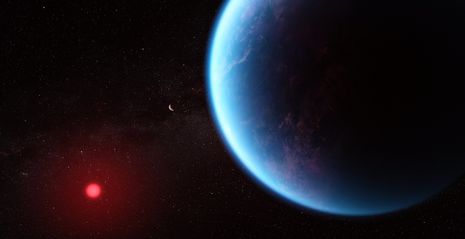Astrophysics professor finds signs of life on faraway planet
Cambridge professor Nikku Madhusudhan found a sulphur molecule, which on Earth is only produced by life, on a planet 120 light years away

Potential signs of life have been detected outside our solar system, according to a new research headed by a Cambridge scholar using NASA’s James Webb telescope.
Professor Nikku Madhusudhan, an astrophysicist from Cambridge’s Institute of Astronomy, found evidence of dimethyl suplphide (or DMS) on the planet K2-18b, 120 light years from Earth.
DMS is a surface sea level, ocean-produced sulphur compound, which is released into the atmosphere, and is critical to the “global sulphur cycle”. On Earth, it is only produced by life.
“The bulk of it in Earth’s atmosphere is emitted from phytoplankton in marine environments,” Professor Madhusudhan explained.
Although the James Webb Space Telescope has detected the presence of DMS in the chemical signatures of the planet’s light, researchers have stressed that the finding is uncertain and requires further investigation.
Madhusudhan stipulates that the finding is tentative and will not be confirmed until more data can be analysed, with results expected in a year’s time.
Discoveries of signs of life have ended in disappointment in the past. Announcements from three years ago that phosphine gas had been detected in the clouds of Venus have since been disputed.
But despite underlining the need for caution, Madhusudhan has admitted that the findings are “a huge deal”, telling the BBC that his entire team were ″shocked″ when they saw the results.
This is the first time that DMS has been detected by astronomers in a planet orbiting a distant star.
Planet K2-18b orbits a cool red dwarf star, with temperatures low enough for potential life to exist. DMS has been found alongside methane and CO₂ “in abundance”, suggesting that the planet could have a water covered surface or ocean, pointing to the potential for life. Astronomers have been researching the planet since 2019, after finding signs of potential water vapour.
Subhajit Sarkar, research team member from Cardiff University, said “sub-Neptune” planets like K2-18b are poorly understood despite being the “most common type known so far in the galaxy”, because they “do not exist in our solar system”.
NASA’s Exoplanet Exploration programme, set up in 2008, seeks to advance scientific understanding on planets like K2-18b which are beyond our solar system.
The implications of the finding also may further advance investigations into signs of life in other galaxies. Dr Robert Massey, deputy director of London-based Royal Astronomical Society told the BBC: “We are slowly moving towards the point where we will be able to answer that big question as to whether we are alone in the Universe or not”.
 Comment / Plastic pubs: the problem with Cambridge alehouses 5 January 2026
Comment / Plastic pubs: the problem with Cambridge alehouses 5 January 2026 News / Cambridge academics stand out in King’s 2026 Honours List2 January 2026
News / Cambridge academics stand out in King’s 2026 Honours List2 January 2026 News / Cambridge businesses concerned infrastructure delays will hurt growth5 January 2026
News / Cambridge businesses concerned infrastructure delays will hurt growth5 January 2026 News / AstraZeneca sues for £32 million over faulty construction at Cambridge Campus31 December 2025
News / AstraZeneca sues for £32 million over faulty construction at Cambridge Campus31 December 2025 Interviews / You don’t need to peak at Cambridge, says Robin Harding31 December 2025
Interviews / You don’t need to peak at Cambridge, says Robin Harding31 December 2025










